The world of hunting demands dogs that are sharp, adaptable, and ready for anything—and some breeds rise to the challenge with remarkable versatility.
In real-world tracking and hunting situations, breeds that combine endurance, intelligence, and scenting ability rise to the top. They handle changing terrain, shifting weather, and varied prey — adaptivity is key.
Versatility in a hunting dog means more than just a strong nose. It means the capacity to point, trail, retrieve, or drive game, depending on the situation, and the willingness to work closely with its handler.
In this guide, we’ve selected nine breeds known for their tracking success across upland birds, big game, or dense forest work. Each breed brings a unique strength, yet shares common traits: stamina, instinct, and cooperation.
Whether you’re walking open plains or thick woods, the right dog partner can transform your experience. The right tracking breed really counts when you need reliability in unpredictable conditions.
Most Versatile Hunting Dog Breeds for Any Tracking Scenario
1. German Shorthaired Pointer
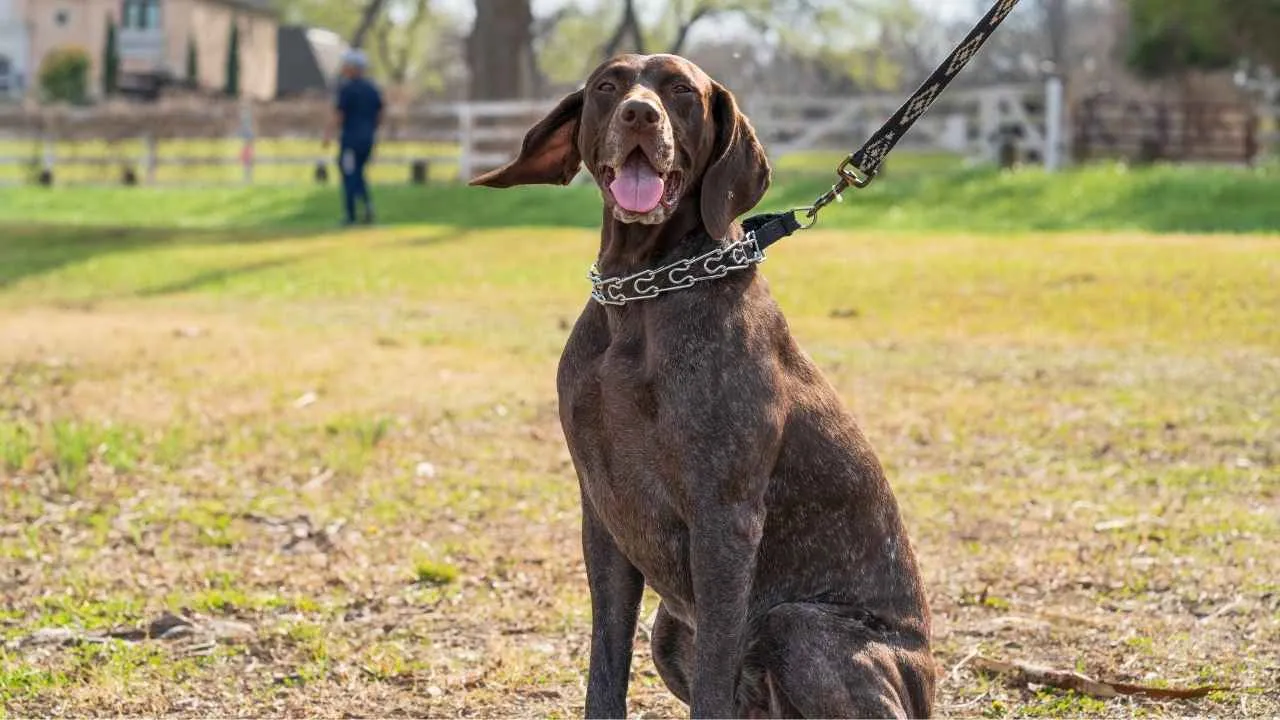
Few breeds combine athleticism, responsiveness, and all-terrain hunting skill like the German Shorthaired Pointer. This dog thrives in active training sessions due to its sharp mind and eagerness to work with its handler.
Hunters often appreciate its cooperative spirit, which helps the GSP master complex field commands quickly.
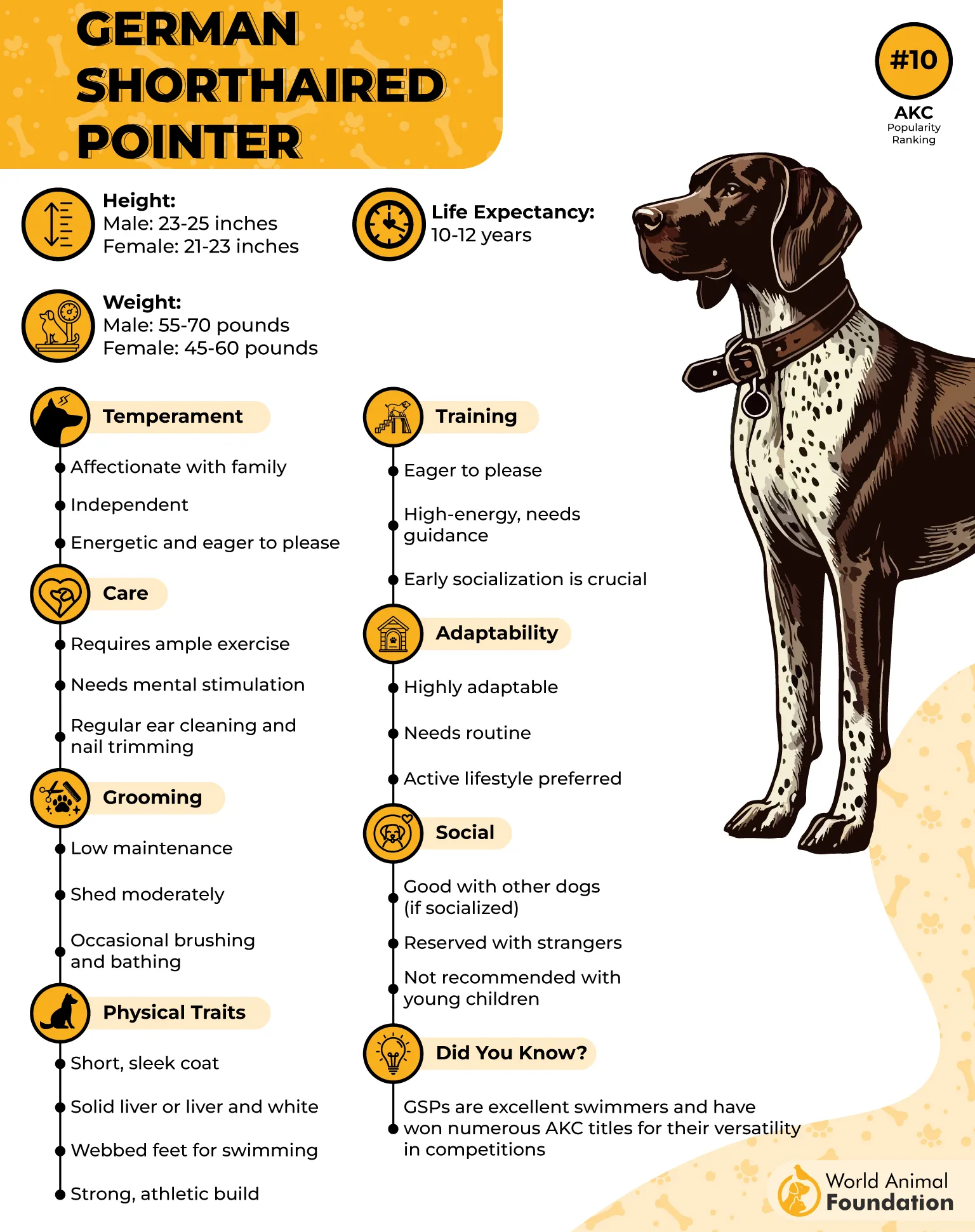
AKC claims that built for versatility, the GSP moves with quick precision across fields, wetlands, and dense cover. Its power and stamina allow it to switch from pointing upland birds to retrieving waterfowl within the same outing. Field performance feels natural, making it a favorite in multi-scenario hunting.
Tracking Style & Scenting Ability
• Strong air-scenting instincts
• Excellent for locating moving birds
• Swift transition from locating to retrieving
Best Fit for Hunter Type
• Hunters needing an all-purpose companion
• Active outdoorsmen who hunt multiple game types
• Owners who enjoy fast-paced fieldwork
The GSP traces its roots to 19th-century Germany, where breeders merged pointing, retrieving, and endurance traits into one dog. It was crafted as the ultimate multipurpose gun dog. Today, it continues to impress with a field-ready mindset and remarkable adaptability.
Regular conditioning, swimming, and long runs keep the GSP in prime shape. It thrives on engagement; low-activity lifestyles can dull its natural drive. Some owners note its need for mental exercise due to its high intelligence.
2. Weimaraner

The Weimaraner stands out with its bold personality and strong determination in the field. Many hunters admire how quickly this breed forms a bond and learns advanced tasks, creating a dependable working partnership. Its training style thrives on consistency and dynamic challenges.

In active hunting environments, the Weimaraner shows impressive speed, handling large expanses of land with fluid movement. Its ability to chase, track, and return game makes it especially valuable in open terrain. The breed blends energy with tactical problem-solving, producing excellent field outcomes.
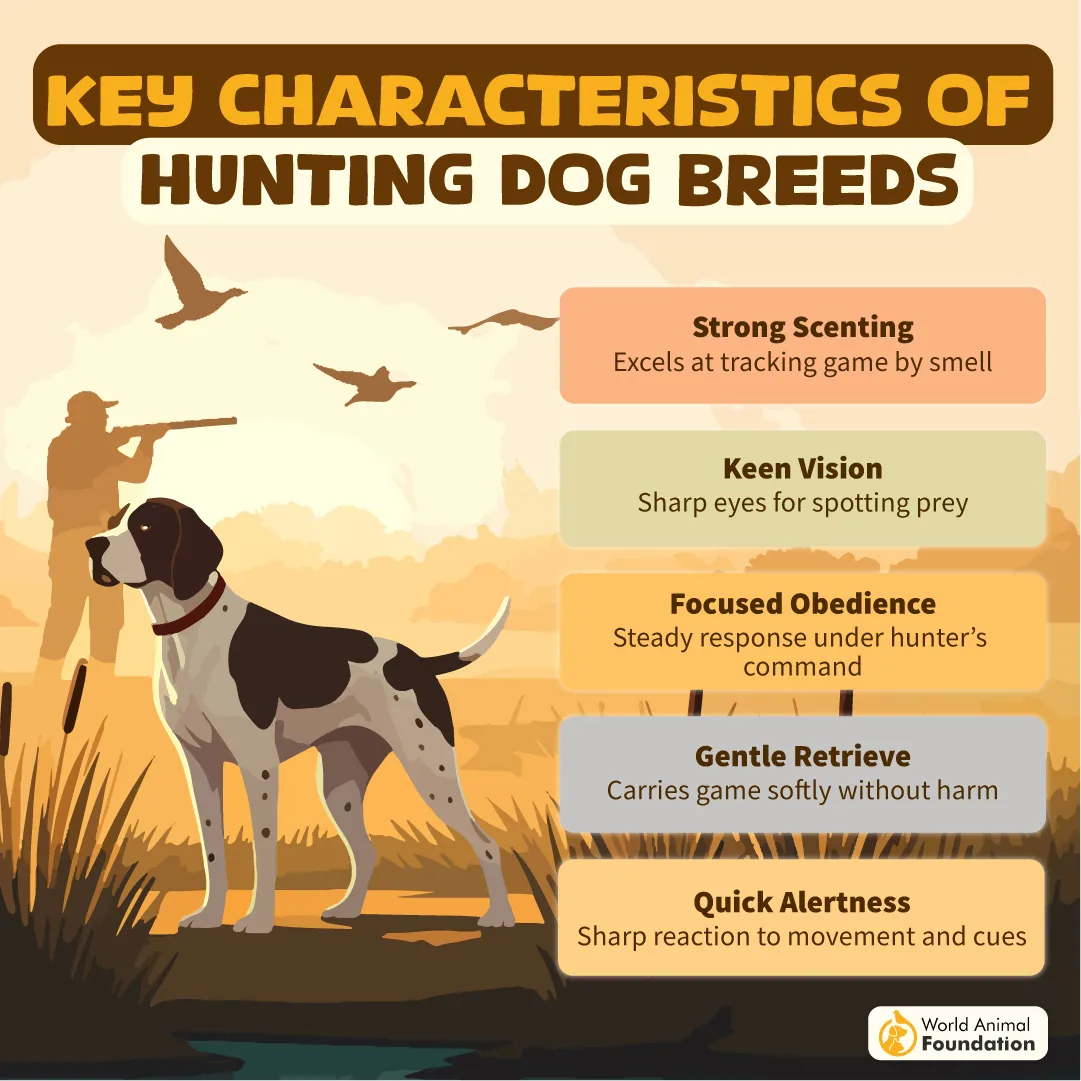
Tracking Style & Scenting Ability
• Able to detect ground scent
• Reliable trailing abilities across wide areas
• Excels at locating larger game animals
Best Fit for Hunter Type
• Hunters working in open fields
• Experienced handlers seeking a driven dog
• Outdoorsmen who enjoy long-distance pursuits
Originating in early 19th-century Germany, the Weimaraner was bred for tracking big game like boar and deer. These beginnings shaped the breed’s signature stamina and forward-driving instinct. Its heritage still influences its performance in modern hunting scenarios.
PetMD suggests that exercise is essential for this high-energy companion; long hikes and structured work help maintain muscle and focus. Owners should monitor their strong prey drive. Some Weimaraners may require additional recall training due to their intense curiosity.
3. Black and Tan Coonhound

The Black and Tan Coonhound stands out through its calm confidence and steady training temperament. Many handlers appreciate its patient learning pace, giving this breed a thoughtful working style. With the right guidance, it matures into a loyal, consistent tracking partner.
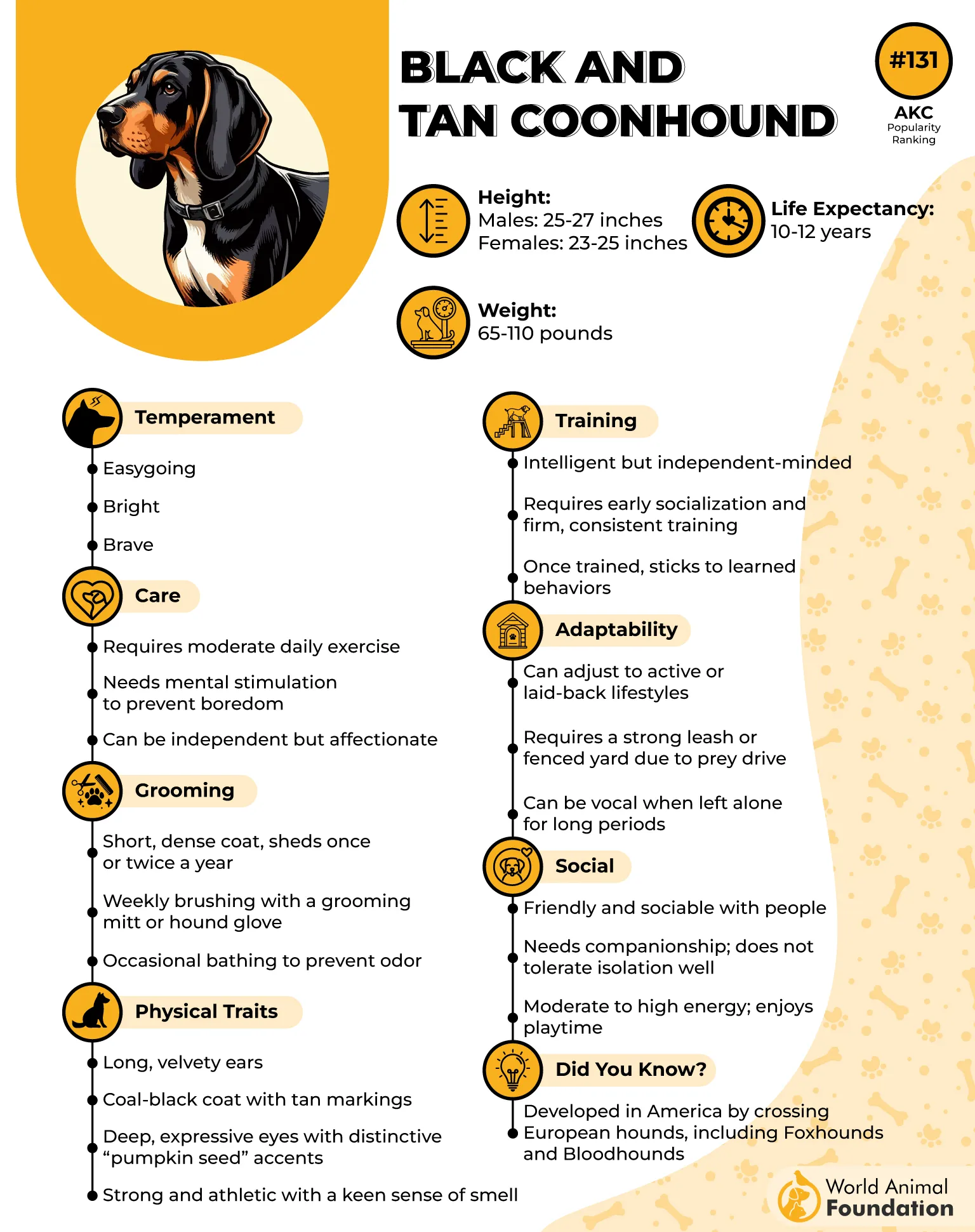
Out in the woods, this Hound moves with deliberate purpose, using its keen senses to trail game over long distances. Its endurance makes it effective for nighttime pursuits. Hunters often trust this breed for difficult scent trails that require persistence.
Tracking Style & Scenting Ability
• Cold-trail specialist
• Skilled in long, complex scent lines
• Exceptional scent discrimination
Best Fit for Hunter Type
• Hunters who enjoy long, rugged pursuits
• Trackers focused on treeing game
• Handlers wanting slow, reliable precision
WebMD states that this breed originated from American and European scent Hound lineages, developed for raccoon and big-game tracking. Its working heritage emphasizes long hunts requiring patience and deep concentration. Over time, it became a valued partner in challenging forest terrain.
Daily activity, structured tracking exercises, and opportunities to use its nose help keep the Black and Tan engaged. It can be vocal when excited on a trail. Owners should provide supervised roaming, since this hound may follow scent paths beyond property lines.
4. Bluetick Coonhound
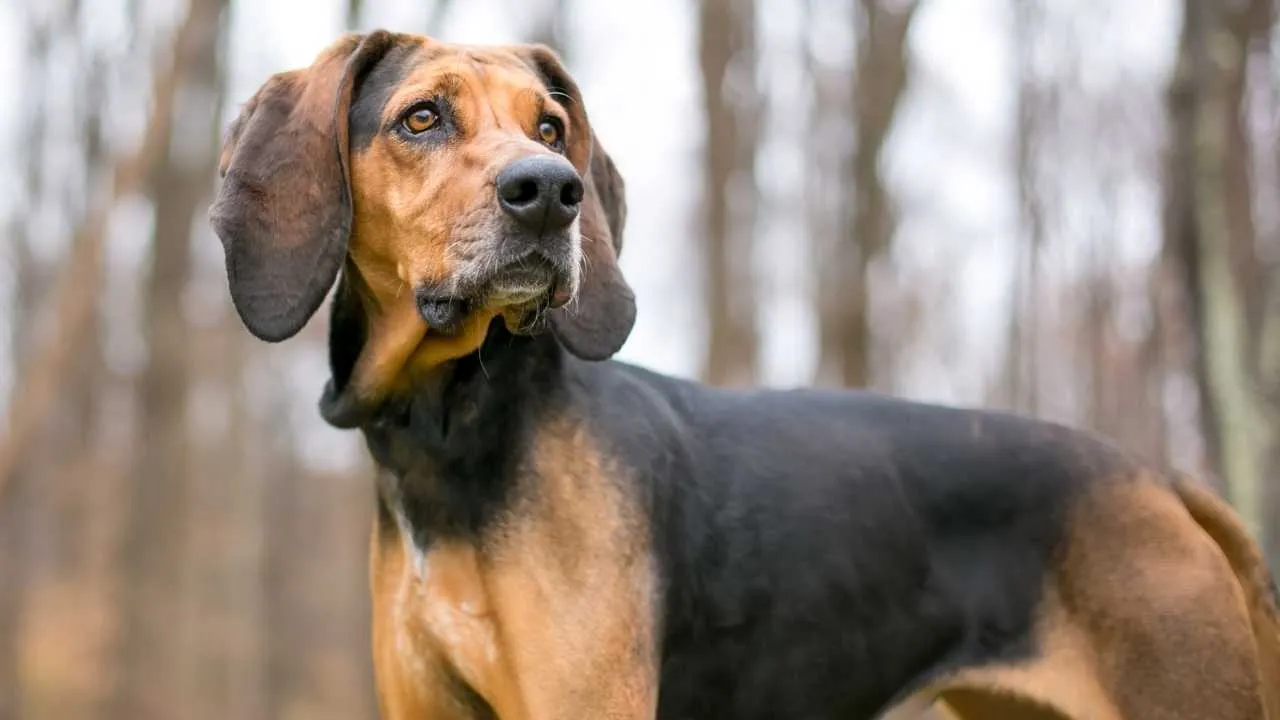
The Bluetick Coonhound stands out with its bold tracking drive and enthusiastic working personality. Trainers often enjoy their determination and willingness to tackle tough scent challenges. It learns best through field-based tasks that let it practice real-world tracking skills.

In action, the Bluetick displays vigorous movement and persistence, known to stay on a trail for hours. Its accuracy on older scent lines makes it a reliable choice for hunters working in dense forest areas. These traits create a powerful combination of intensity and skill in the field.
Tracking Style & Scenting Ability
• Excellent cold-nosed tracking
• Proven ability on aged trails
• Consistent performance in dense cover
Best Fit for Hunter Type
• Hunters navigating forest environments
• Handlers wanting high-drive, vocal trailers
• Outdoorsmen who appreciate stamina-driven dogs
With origins in American hound lines, including the French Bleu de Gascogne, the Bluetick evolved into a premier treeing and tracking companion. Its heritage shaped its signature persistence and signature bawl on the trail. Generations of selective breeding produced a hound capable of intense field focus.
This breed performs best with frequent exercise and opportunities to track scents during training. It may require patience due to its independent streak. Owners should be prepared for louder vocalization, especially during hunts.
5. Bloodhound

The Bloodhound stands apart through its unrivaled scenting power and thoughtful training nature. Handlers often remark on its gentle personality combined with unmatched tracking potential. Its training thrives on repetition, scent games, and calm handling.

Few hunting dogs can match the Bloodhound’s precision on complex trails. It follows faint scent signatures with remarkable dedication, known for trailing long after the scent begins to fade. Many hunters rely on it for tracking wounded game across large, challenging landscapes.
Tracking Style & Scenting Ability
• World-renowned scent detection
• Outstanding long-distance trailing
• Highly accurate cold-trail ability
Best Fit for Hunter Type
• Hunters needing advanced tracking support
• Handlers focused on deep-woods pursuits like wild boar and deer hunting
• Outdoorsmen who value scent-specific reliability
Bloodhounds hail from medieval European tracking dogs, used by nobles and wardens for locating game and people. This long working history shaped their incredible scent focus. Their heritage still influences their modern roles in fieldwork, search efforts, and specialized tracking.
Regular conditioning and supervised outdoor time are important to maintain strength and mobility. Bloodhounds can drool heavily and require consistent grooming around the face and ears. Their intense focus may lead them far along a scent trail, so strong recall habits are essential.
6. Catahoula Leopard Dog

The Catahoula Leopard Dog stands out with its bold working attitude and sharp decision-making skills. Many handlers appreciate its instinctive problem-solving during training sessions, which gives this dog a confident, independent style.
It responds best to structured leadership and active, hands-on guidance in the field.
Known for covering rough ground with ease, the Catahoula uses its agility and grit to manage intense hunting conditions. It excels at tracking and baying large game, especially in swampy or heavily wooded terrain. Its field performance feels powerful and highly responsive in fast-moving scenarios.
Tracking Style & Scenting Ability
• Strong ground-tracking instinct
• Effective on winding or fast-changing scent paths
• Uses both scent and visual cues on the move
Best Fit for Hunter Type
• Hunters working in rugged or wet environments
• Handlers who prefer assertive, high-drive dogs
• Outdoorsmen focused on big-game pursuits
Developed in Louisiana, the Catahoula was originally bred for herding and later for hog hunting and versatile tracking work. Its Southern working heritage shaped a dog capable of thriving in unpredictable terrain. The breed still carries this resilient spirit into modern tracking and hunting.
Catahoulas benefit from consistent physical conditioning, mentally challenging tasks, and secure outdoor spaces. Their determination can lead them far from home if not guided with strong boundaries. Some individuals need early socialization to balance their natural intensity.
7. English Pointer
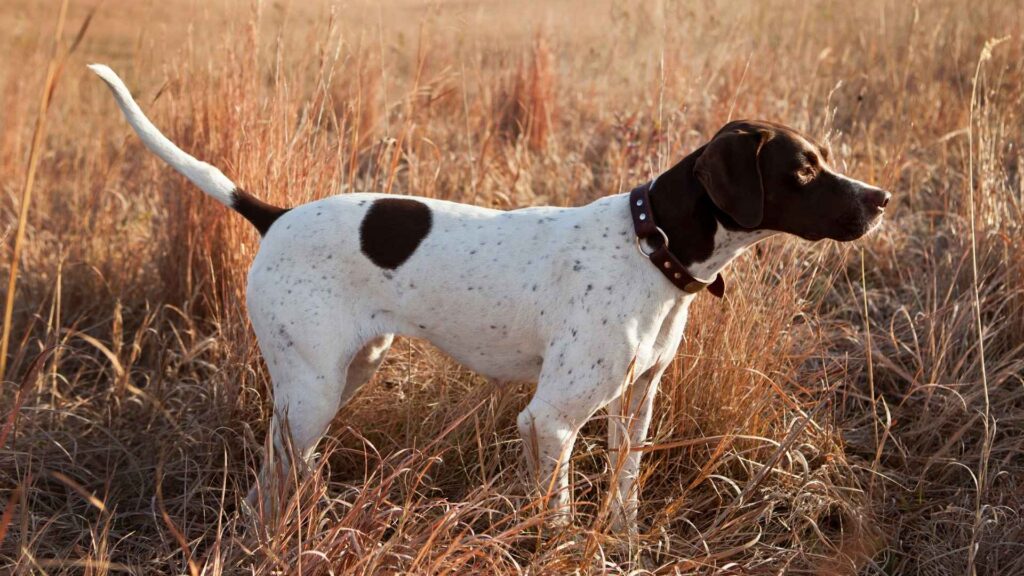
The English Pointer stands out through its graceful athleticism and composed training temperament. Hunters often admire its willingness to learn complex commands and its naturally steady behavior during pointing work. Training tends to flow smoothly due to its receptive and focused nature.
In the field, the English Pointer sweeps across open land with remarkable speed and elegance. It is built for locating game at long distances, using its efficient gait and elevated head carriage. This breed shines in upland bird hunting thanks to its precision and stamina.
Tracking Style & Scenting Ability
• Exceptional airborne scent detection
• Rapid, wide-range searching
• Strong pointing instincts
Best Fit for Hunter Type
• Upland bird hunters
• Those who enjoy expansive hunting fields
• Handlers who value refined pointing skills
Originating in England during the 17th century, the Pointer was bred to locate gamebirds long before the shot. Its heritage blends agility, endurance, and remarkable scenting focus. Over centuries, it has become one of the most respected pointing dogs in the world.
This breed thrives with regular running, sprint training, and field practice. It may grow restless without adequate activity due to its natural energy. Owners should provide open-space exercise to keep this athlete in peak form.
8. Beagle
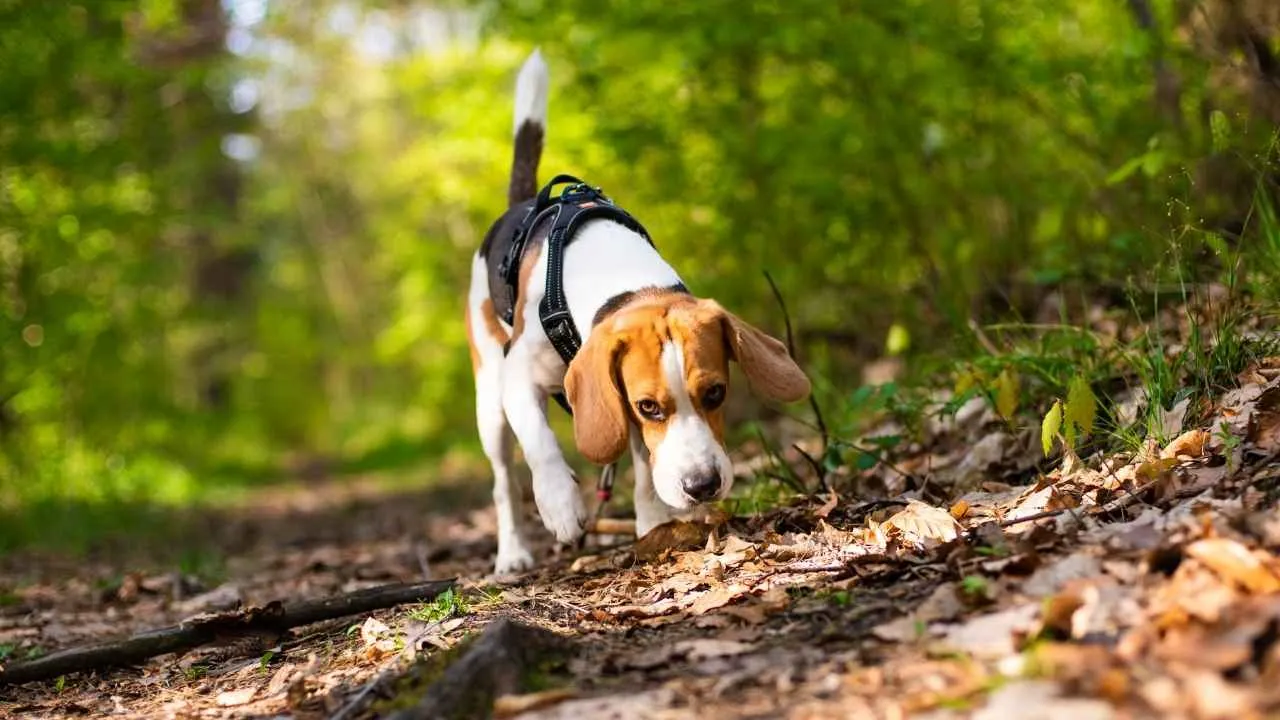
The Beagle stands out with its cheerful personality and surprisingly sharp working intelligence. Trainers often enjoy its mix of curiosity and persistence, making sessions lively and rewarding. It responds best to positive reinforcement and scent-based activities.
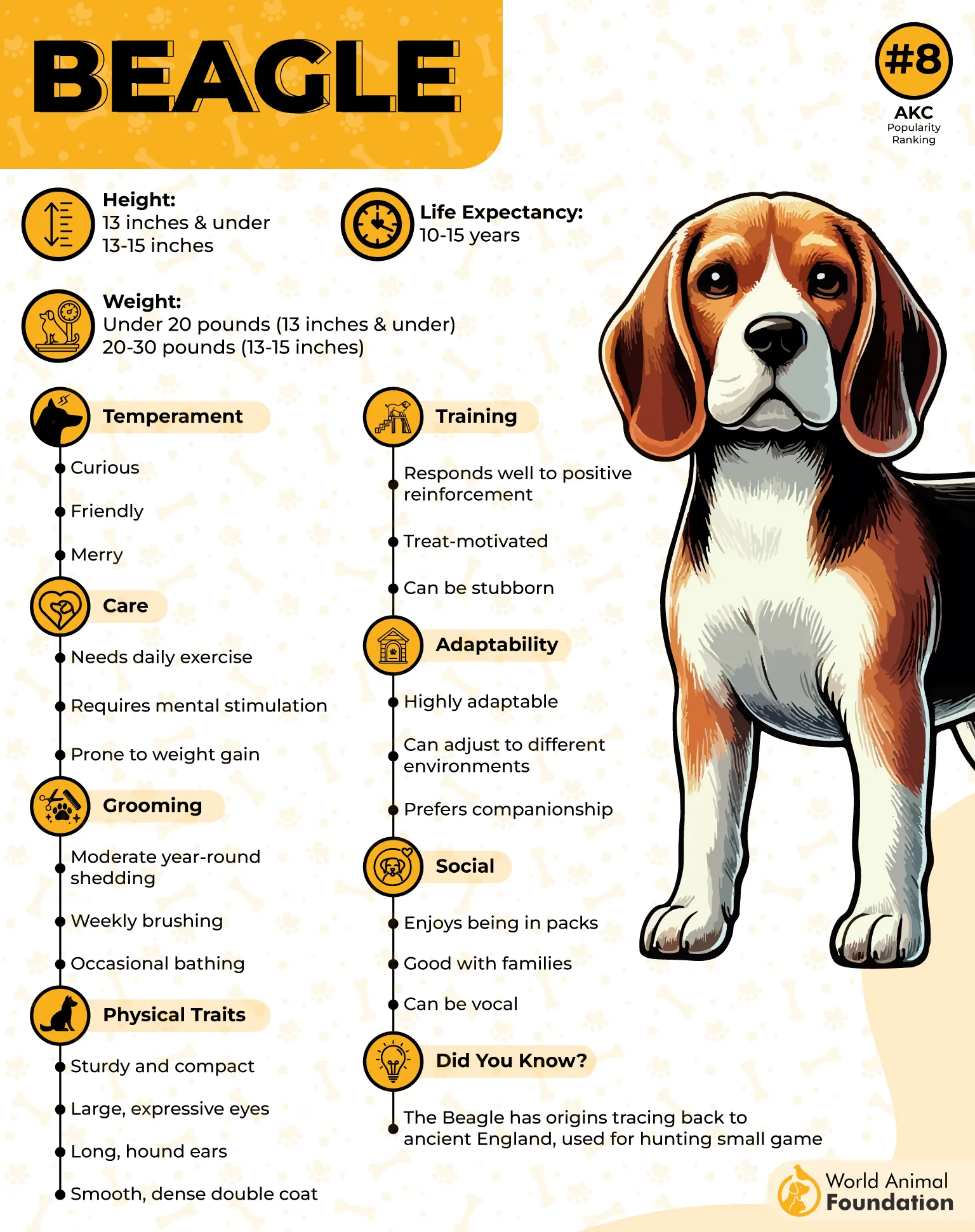
Once in hunting mode, the Beagle reveals impressive tracking drive for its size, moving swiftly through brush and dense cover. It excels at pursuing small game with joyful determination. Its compact frame and endurance add versatility across various tracking scenarios.
Tracking Style & Scenting Ability
• Skilled ground-trailing ability
• Very accurate on fresh scent lines
• Highly focused once engaged in a trail
Best Fit for Hunter Type
• Hunters pursuing rabbits or small game
• Those seeking portable, manageable dogs
• Families who want a hunting companion with a friendly temperament
The Beagle’s lineage stretches back to ancient scent hounds used in England for rabbit and hare hunting. Its working heritage emphasizes perseverance and strong nose-to-ground tracking. These traits still define the breed’s hunting strengths.
Routine exercise, enrichment games, and structured walks support the Beagle’s active mind. It has a strong inclination to follow scents, which may lead it to wander, so secure areas are important. Some Beagles require extra patience during recall training due to their intense focus on trails.
9. Basset Hound
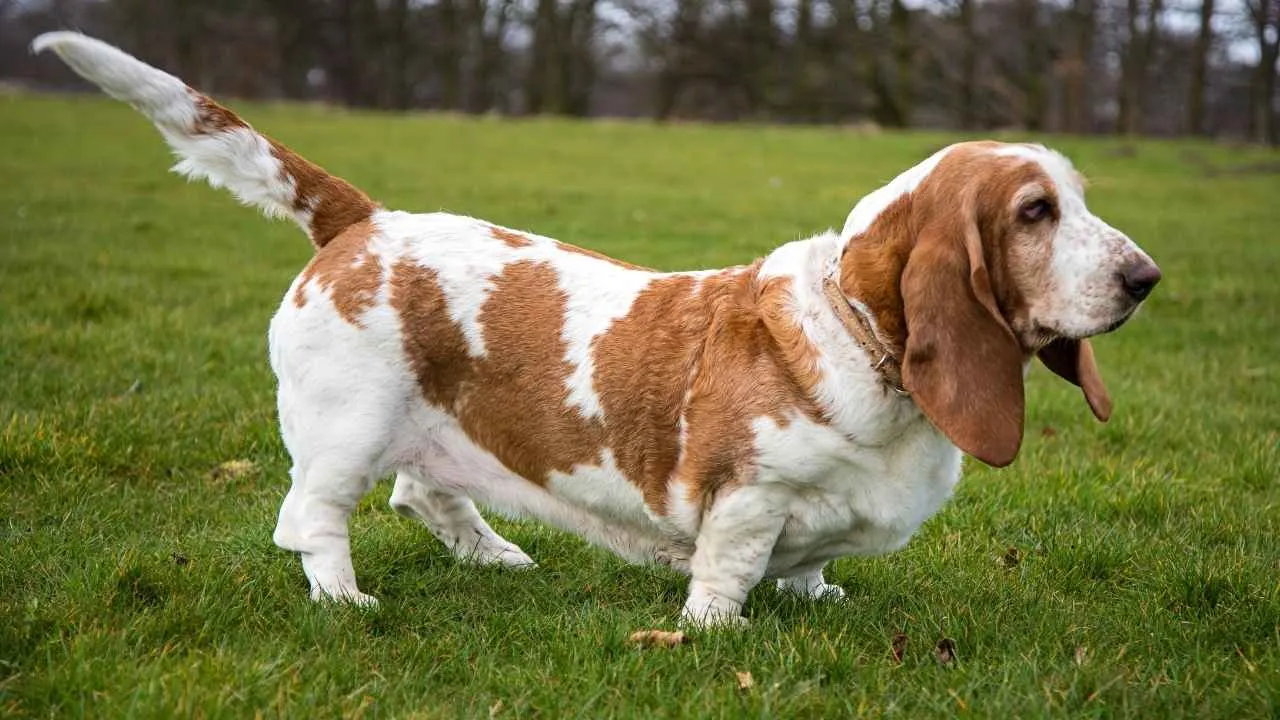
The Basset Hound stands out with its remarkable sense of smell, scent accuracy, and calm training approach. Handlers appreciate its steady temperament, which allows it to absorb new tasks at a comfortable pace. This dog enjoys scent-based learning far more than repetitive obedience drills.

Out in the field, the Basset’s low build helps it move methodically through brush to follow scent trails that other dogs miss. Its ability to stay committed to an aged track makes it a strong choice for slow, thorough tracking. Many hunters value its patience and reliability during long pursuits.
Tracking Style & Scenting Ability
• World-class ground-trailing skill
• Effective on older scent trails
• Strong pack-tracking instincts
Best Fit for Hunter Type
• Hunters who prefer deliberate, careful tracking
• Those working in brush-filled environments
• Handlers seeking a laid-back working companion
Originating from French scent hounds, the Basset was bred for trailing small game with accuracy and endurance. Its design favored long-distance ground tracking at a slow pace. This heritage remains at the heart of its hunting behavior today.
Exercise, scent games, and weight management help maintain the Basset’s health and stamina. Their long ears and skin folds need routine cleaning. They can be independent, so early training builds good habits for working life.
Conclusion
The world of hunting breeds is wide, and beyond the ones covered above, dogs like the Plott Hound, Irish Setter, English Setter, and Hanover Hounds offer unique strengths across various game.
Many hunters rely on these versatile dogs for tasks ranging from upland game birds to deer hunting and blood tracking in rough terrain.
Their acute sense and ability to support hunting trips in shifting conditions make them dependable, loyal companions for the great outdoors. These dogs can assist with pursuing game, locating small animals, or working through cold water.
If you’re exploring other breeds or seeking the perfect match for your style, keep learning and invest in proper training. Ready to choose your next field partner?

